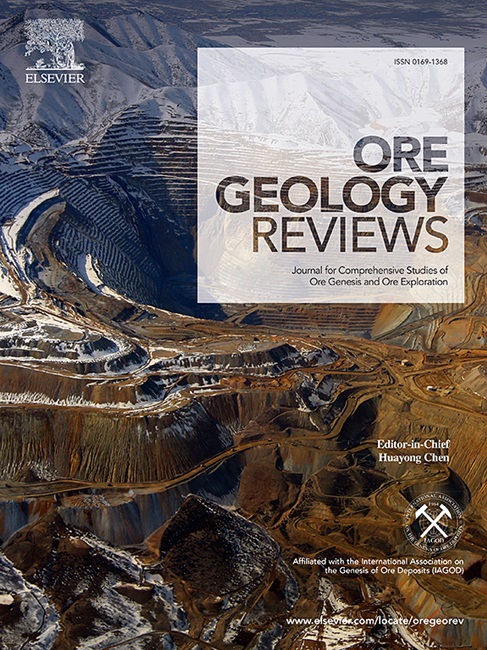额尔古纳地块早侏罗世斑岩-夕卡岩Cu-Mo-Pb-Zn体系——以下虎林矿床为例
IF 3.6
2区 地球科学
Q1 GEOLOGY
引用次数: 0
摘要
最近在额尔古纳地块发现的下虎林矿床是典型的矽卡岩型铅锌矿床。但其成矿机制、构造背景及其在区域成矿体系中的作用尚不清楚。为了解决这些知识空白,本研究调查了H-O-S-Pb同位素、流体包裹体(FIs)、U-Pb地质年代学和地球化学分析。下虎林矿床在震旦系额尔古纳河大理岩与早侏罗世斑岩花岗岩接触带内发现铅锌矿化。成矿阶段分为矿石前矽卡岩阶段(ⅰ)、矿石同期石英-硫化物阶段(ⅱ)和矿石后石英-方解石阶段(ⅲ)。观察到三种类型的FIs:富气,富液和含盐。I、II和III阶段的FI均质温度范围为345-445°C、260-365°C和165-258°C,盐度范围分别为6.7-49.1、4.6-15.6和3.7-8.1 wt% NaCl当量。H-O同位素资料表明,成矿流体起源于岩浆水后,在运移过程中逐渐被大气水稀释。Pb-Zn析出的主要机制是相分离和稀释。S-Pb同位素资料表明,斑岩花岗岩和震旦系额尔古纳河大理岩是成矿物质的来源。斑岩花岗岩作为成因侵入物,U-Pb年龄为199.7±1.5 Ma,与区域斑岩Cu-Mo成矿作用(206 ~ 181 Ma)一致。地球化学特征表明,与区域斑岩-夕卡岩型Cu-Mo-Pb-Zn成矿有关的侵入体具有相似的特征,表现出与俯冲有关的火山弧背景下的易达质特征和形成过程。本文提出了鄂尔古纳地块内与蒙古-鄂霍次克洋构造机制相联系的早侏罗世斑岩-夕卡岩型Cu-Mo-Pb-Zn成矿模式。该模型加深了我们对区域成矿过程的认识,为指导找矿提供了新的思路。本文章由计算机程序翻译,如有差异,请以英文原文为准。

Early Jurassic porphyry–skarn Cu–Mo–Pb–Zn system in the Erguna Block, NE China: A case study of the Xiahulin deposit
The Xiahulin deposit, recently discovered in the Erguna Block, northeastern China, represents a typical skarn Pb–Zn deposit. However, its ore-forming mechanism, tectonic setting, and role within the regional metallogenic system remain unclear. To address these knowledge gaps, this study investigates H–O–S–Pb isotopes, fluid inclusions (FIs), U–Pb geochronology, and geochemical analyses. At the Xiahulin deposit, Pb–Zn mineralization is noted within the contact zone between the Sinian Ergunahe marble and the Early Jurassic porphyritic granite. The following three mineralization stages were identified: the pre-ore skarn (I), the syn-ore quartz–sulfide (II), and the post-ore quartz–calcite (III). Three types of FIs were observed: vapor-rich, liquid-rich, and halite-bearing. The FI homogenization temperatures for stages I, II, and III range from 345–445 °C, 260–365 °C, and 165–258 °C, with salinities ranging from 6.7–49.1, 4.6–15.6, and 3.7–8.1 wt% NaCl equivalent, respectively. According to H–O isotope information, the ore-forming fluids, after originating from magmatic water, were diluted progressively by meteoric water during migration. The principal mechanisms driving Pb–Zn precipitation were phase separation and dilution. According to the S–Pb isotope information, the porphyritic granite, and the Sinian Ergunahe marble constituted the sources of ore-forming substances. The porphyritic granite, as the causative intrusion, displayed a U–Pb age of 199.7 ± 1.5 Ma, consistent with the regional porphyry Cu–Mo metallogenesis (206–181 Ma). The geochemical characteristics indicate that the intrusions associated with regional porphyry–skarn Cu–Mo–Pb–Zn metallogenesis share similar characteristics, exhibiting adakitic signatures and formation within a subduction-related volcanic arc setting. Herein, we propose an Early Jurassic porphyry–skarn Cu–Mo–Pb–Zn metallogenic model linked to the Mongol–Okhotsk Ocean tectonic regime within the Erguna Block. This model deepens our understanding of regional metallogenic processes and provides insights to guide mineral exploration.
求助全文
通过发布文献求助,成功后即可免费获取论文全文。
去求助
来源期刊

Ore Geology Reviews
地学-地质学
CiteScore
6.50
自引率
27.30%
发文量
546
审稿时长
22.9 weeks
期刊介绍:
Ore Geology Reviews aims to familiarize all earth scientists with recent advances in a number of interconnected disciplines related to the study of, and search for, ore deposits. The reviews range from brief to longer contributions, but the journal preferentially publishes manuscripts that fill the niche between the commonly shorter journal articles and the comprehensive book coverages, and thus has a special appeal to many authors and readers.
 求助内容:
求助内容: 应助结果提醒方式:
应助结果提醒方式:


